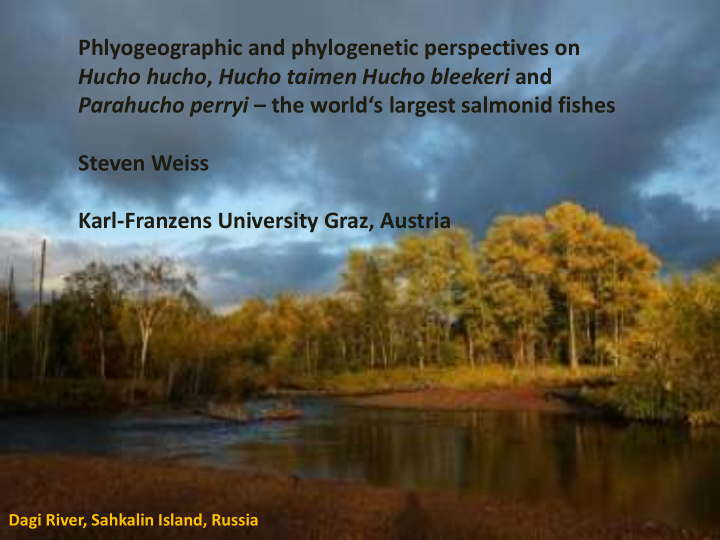



Phlyogeographic and phylogenetic perspectives on Hucho hucho , Hucho taimen Hucho bleekeri and Parahucho perryi – the world‘s largest salmonid fishes Steven Weiss Karl-Franzens University Graz, Austria Dagi River, Sahkalin Island, Russia
Global Distribution of the Species
Salmonoid Phylogeny (schematic) Stenodus Prosopium Hucho bleekeri Hucho taimen Hucho hucho Coregonus Hucho (?) ishikawae Thymallus Hucho Brachymystax Parahucho Salmo Salmonidae Oncoryhnchus Salvelinus Salvethymus ? Parahucho perryi
Salmonidae Phylogeny (mtDNA, ca. 1700 bases) (ATP6 + partial Control region + partial NADH-1) Parahucho perryi all exhibit anadromy 94 Salvelinus – alpinus + fontinalis Onchorhynchus mykiss 97 Salmo Brachymystax 99 Hucho hucho Hucho bleekeri 99 Hucho and Brachymystax do not exhibit anadromy Hucho taimen Strong support for Salmonidae, sister-group status for Hucho and Brachymystax and monophyly for Hucho Coregonus Thymallus
Distribution Area of Danube salmon Hucho hucho The original (Danube endemic) distribution was limited to montane tributaries and thus much of this territory, and especially the lowlands of Hungary, Romania and Bulgaria are not Map of the Danubian basin, showing the original distribution range Hucho habitat. of Hucho hucho (in grey) as well as the sampling locations (numbered 1-11, and corresponding to the names listed in Table 1 (Weiss et al 2010) H. hucho has lost approximately two thirds of ist range overall ( Holčik et al. 1988) and 90% of its range within Austria (Schmutz et al 2003). In Austria there are reproducing populations in at least the Mur, Gail und Pielach rivers. Hucho exists in Germany (Bavaria), Slovenia, Bosnia-Herzegovinia, Ukraine, Czech Republic, Croatia, Serbia, Montenegro, Slovakia, Hungary and Poland. In many rivers, the question arises whether or not populations are self-sustaining, that is would they exist without stocking measures. In the most southern regions (e.g. Montenegro) there is no stocking of Hucho . Nonetheless, illegal fishing is a major problem there, and population densities are extremely low.
Very low levels of genetic diversity across the entire distribution area – four closely related mtDNA haplotypes across over 1800 base pairs
For the four sequence haplotypes, no phylogeographic structure across the range could be found. However, by sequencing across an 82 bp repeat in the mtDNA control region, a statiscially significant structure was revealed based on the number of repeats.
Caught in Plav Lake, Montenegro in 2004, reportedly 135 cm in total length and 37 kg in weight.
Chain of low-head (7 to 15 MW) hydropower plants on the Mur River in Austria Largest remaining populations of Huchen in Austria Estimated 1500 adults left in the Mur River, by far the largest population in Austria. 31 dams existing, four more in adanced stages of planning, including the first new dam in the upper Mur, inside a „Natura 2000“ area. No sign of governmental interest in stopping ANY dam construction due to species protection Interests.
Media engagement against government and power company propaganda
Documented hydropower plants on Austrian rivers with a catchment area > 10 sq. km The environmental ministry as well as numerous lobbying groups are calling for expanding hydropower to its fullest potential in Austrian rivers, with no regard to protected areas, outside of a few high elevation national parks
Siberian Taimen Phylogeography - 2005
Hucho taimen
Haplotype network for Hucho taimen across all of Russia Three clades are evident, with significant basin haplotype sharing Ob, Enisey, and Volga Some presumably ancestral haplotypes in the upper Enisey Basin near Baikal and The Amur and Lena basins Haplotype divergence spans only approximately 1.5% and clades are separated by a maximum of 0.5%.
Distribution of Parahucho perryi
Parahucho perryi – Dagi River expedition
Haplotype network for P. perryi (< 1% divergence) Parahucho perryi 70 individuals, no phylogeographic structure across the range
Factorial Correspondence Analysis based on 10 microsatellite loci (Outliers removed, coded by major drainage) Sakhalin Russian mainland Hokkaido
Factorial Correspondence Analysis based on 10 microsatellite loci (coded by population) Vabaisky Lakes Sakhalin Nabile Dagi
Summary Hucho hucho – limited „ endemic “ distribution, extremely low levels of mtDNA variation, self-reproducing populations still in decline. Where investigated, moderate levels of Variation at the population level, very little regional data on self-reproducing status of populations Hucho bleekeri – more or less equally diverged from H. hucho, and H. taimen, extremely Limited distribution, no further genetic information avaialble. Hucho taimen – very large distribution, limited mtDNA variation for such a large range, some lineage diversification across major drainages, potentially relevant for conservation Purposes, Ural specimens clearly H. taimen. Hucho ishikawae – no data Parahucho perryi – clearly distinct genus, limited distribution, mtDNA variation moderate, but no sign of phylogeographic structure with the exception of a few isolated populations, limited population genetic structure, some signs of inbreeding.
THANK YOU! (and special thanks to Pete Rand of the Wild Salmon Center) Mur River, City Center Graz, Austria
Recommend
More recommend